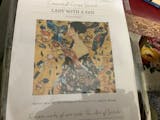Paul Kapell (1)
Paul Kapell (1909–1982) was a French artist known for his works in the mid-20th century, primarily as a painter and graphic artist. His art, influenced by modernist movements and abstract expressionism, set him apart as a unique voice in post-war French art.
Kapell was trained at the prestigious École des Beaux-Arts in Paris, where he studied the traditional techniques of classical painting. This foundation in realism and classical methods would serve as a base from which he later evolved into a more abstract, modernist style. His early works reflect a solid understanding of form, light, and perspective.
In addition to his fine art paintings, Kapell was also involved in graphic art and illustration. His experience as a graphic artist allowed him to experiment with different media and techniques, which often spilled over into his more traditional works. His graphic designs show a more structured, precise side of his creativity, in contrast to the free-form abstraction seen in his paintings.
Kapell continued to paint and exhibit his works throughout his life, contributing to the ongoing conversation about abstraction and expression in the art world. His influence is especially notable within the context of post-war French art, a period marked by experimentation and a search for new forms of expression. Though he did not become a household name, his dedication to exploring the depths of emotion and abstraction has left a lasting impression on the art community.








